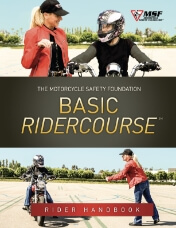| 1 | Course Introduction |
- RiderCourse Program Objectives
- About This Online Basic eCourse
- eCourse Structure
- eCourse Requirements
- Intended Audience
- General Information
- Knowledge Check
- Moving On
|
| 2 | Motorcycle Types | - Section Overview
- Definition of a Motorcycle
- The Three Basic Motorcycle Types
- Street
- Dual-Purpose
- Off-Highway
- Knowledge Check
- Moving On
|
| 3 | Controls, Indicators and Equipment | - Section Overview
- Handlebars and Throttle
- Clutch Lever
- Gearshift Lever
- Front Brake Lever and Rear Brake Pedal
- Fuel Supply Valve
- Ignition Switch
- Choke Control
- Other Switches
- Horn Button & Engine Start Button
- Indicators
- Equipment
- Knowledge Check
- Moving On
|
| 4 | About Basic Operation
| - Section Overview
- FINE-C
- Engine Start Procedures
- Engine Stop Procedures
- Clutch Lever and Friction Zone
- Riding Posture
- Turns-Corners-Curves
- Basic Steps for Turning
- Search-Setup-Smooth
- Basic Turning
- Braking
- Stopping
- Total Stopping Distance
- Upshifting
- Downshifting
- Engine Braking
- Knowledge Check
- Moving On
|
| 5 | Preparing to Ride: The Four Preps | - Section Overview
- Motorcycle Fit
- Pre-Ride Inspection
- Tires and Wheels
- Controls
- Lights and Electrics
- Oil and Other Fluids
- Chassis
- Stands
- Maintenance
- Personal Protective Gear
- Head and Brain Protection
- Helmet Basics
- Choosing a Helmet
- Helmet Care
- Windscreens
- Eye and Face Protection
- Foot Protection
- Hand Protection
- Jackets, Pants, Riding Suits
- Rain Protection
- Cold Weather Protection
- Hot Weather Protection
- Mental Attitude
- Knowledge Check
- Moving On
|
| 6 | Risk and Riding | - Section Overview
- Risk Awareness
- Why Crashes Happen
- Risk Acceptance
- What Causes Crashes
- What Is a Good Rider?
- Risk Management
- Self-Awareness
- Knowledge Check
- Moving On
|
| 7 | Basic Street Strategies | - Section Overview
- Positioning – Lane Choice
- Positioning – Lane Position
- Being Visible
- RiderRadar
- Visual Lead Times & Distances
- Total Stopping Distance
- SEE – Search
- SEE – Evaluate
- SEE – Execute
- Knowledge Check
- Moving On
|
| 8 | Strategies for Common Riding Situation | - Section Overview
- Intersections
- Between Intersections
- Blind Spots
- Lane Changes
- Merging
- Curves
- SEE Curves
- Additional Tips for Curves
- Limited Space Maneuvers
- Starting on a Hill
- Obstacles
- Parking
- Road Furniture
- Passing
- Tailgaters
- Night Riding
- Group Riding
- Self-Assessment
- Knowledge Check
- Moving On
|
| 9 | Basics for Emergencies | - Section Overview
- Braking Systems
- Emergency Stop in a Straight Line
- Emergency Stop in a Curve
- Front Tire Skid
- Rear Tire Skid
- Swerving
- Swerving – On a Straight Road
- Swerving – In a Curve
- Brake or Swerve Decision
- Knowledge Check
- Moving On
|
| 10 | Special Riding Situations | - Section Overview
- Road Surfaces
- Carrying Passengers
- Carrying Extra Weight
- Touring
- Wind
- Animals
- Select Maintenance Issues – Tire Failure
- Select Maintenance Issues – Stuck Throttle
- Select Maintenance Issues – Clutch Cable Failure
- Select Maintenance Issues – Weave or Wobble
- Select Maintenance Issues – Drive Train Problem
- Select Maintenance Issues – Engine Seizure
- Knowledge Check
- Moving On
|
| 11 | Rider Impairments | - Section Overview
- Alcohol
- Blood Alcohol Content
- Alcohol’s Duration in the Body
- Drugs
- Intervention
- Distraction
- Other Factors – Fatigue
- Other Factors – Emotions
- Other Factors – Aging
- Other Factors – Riding at the Limit
- Other Factors – Impairment
- Risk – Revisited
- Knowledge Check
|
| 12 | Select Topics | - Licensing Information
- Personal Protective Gear Requirements
- State Motorcycle Equipment Requirements
- State Insurance Requirements
- Consequences for Impaired Riding
|
| 13 | Key Safety Concepts | - Self-Assessment
- Terms and Concepts from the Course
|
| 14 | Next Steps | - Next Steps (Local)
- Moving On
|
| 15 | Range Preparation
| - Section Overview
- Range Safety Rules
- Self-Preparation
- RiderCoach Signals
- General Sequence of Each Range Exercise
- Knowledge Check
- Moving On
|
| 16 | Introduction to Human Factors | - Section Overview
- 360° Videos
- Human Factors
- Physical Skill
- Mental-Perceptual Skill
- Social Skill
- Skills Assessment
- Driving Tendencies
- SEE
|
| 17 | SEE – Search | - Search
- Seeing & Perceiving
- Perception Differences
- Perception Strategy 360
- Perception Strategy
- Traffic Scenes
- Peripheral Vision
|
| 18 | SEE – Evaluate | - Evaluate
- Traffic Signs
- Traffic Traps
|
| 19 | SEE – Execute | - Execute
- Perception and Reaction Time
- Commitment to Safety
- Safe vs. Risky Behavior
- Situational Awareness
- Values, Judgment and Choices
- Central Takeaways
- Virtual Reality Activities
|
| 20 | Conclusion | - Next Steps
- Knowledge Test
- Results & Certificate
|
